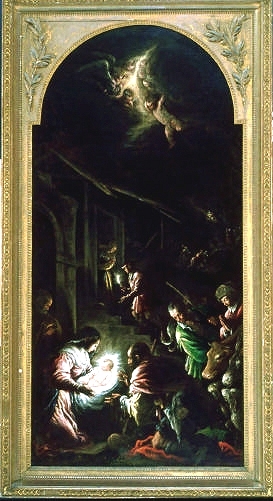 |
|
ADORATION OF THE SHEPHERDS
by Francesco Bassano
Italian 1549-1592, active in Venice and Bassano del Grappo
By: Helen Gokbudak. February 29, 2000
SN88, Oil on Canvas
SUBJECT:
The painting illustrates the text in Luke(2:15-16). “When the angels went away from
them into heaven, the shepherds said to one another,-Let us go over to Bethlehem and see
this thing that has happened, which the Lord has made known to us.” And they went
with haste, and found Mary and Joseph, and the babe lying in a manger.”
In this painting, Francesco sets the adoration of the shepherds at night time. Christ lies
in the manger with Mary, Joseph, and the shepherds looking at the Christ child. There are
angels at the top center of the painting and two cows standing to the right foreground.
DISCUSSION OF THE PAINTING:
The painting c. 1580. is a vertical night scene with the Christ child in the manger at the
left foreground with the brightest luminous light coming from around Christ and the
manger, Mary and Joseph are kneeling by the manger with the light from the manger
illuminating them. The shepherds standing on the right foreground, with much lesser light
around them, cows are standing to the very right foreground of the picture. The angels are
at the top of the painting and are diffuse without sharp edges, the second strongest
luminescence is coming from this area. The color is dark, shading is present The subjects
are not looking out at the viewer but are realistic in presentation. |
